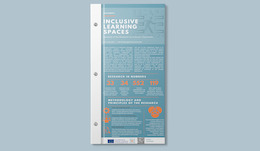Toolbox — For Training and Youth Work
All new tools in your inbox: Be the first to know about new tools for learning with our e-mail notifications.
Report
Inclusive Learning Spaces- Inclusive Class rooms
The research provides profound and wide analytical proof coming from both formal and non- formal education fields from 4 European countries on how escape adventures foster inclusion in classrooms and other learning environments.
Aims of the tool
The aim of the research is to monitor, analyse and evaluate the impact of educational escape adventures in the process of creating inclusive learning environments in formal and non-formal education fields.
The research identifies which elements of escape adventures support the inclusion process and the learning process. Therefore this research contributes to the understanding of how these learning and inclusion processes work and how they can be optimised in the various educational fields.
Description of the tool
The research provides profound and wide analytical proof coming from formal and non- formal education fields from 4 different European countries on how escape adventures foster inclusion in classrooms and other learning environments. The target group of the research were educators from formal and non-formal education, researchers, local authorities, youth workers and young people.
The impact of the escape adventures has been analysed on how the popular leisure time activity-based on the escape rooms have been transformed into inclusive and educational escape adventures and used for educational purposes in different countries, simultaneously with the aim to create more inclusive and engaging classrooms and other learning spaces.
This research could be used as fundamental material on national and European level to promote innovative tools (escape adventures) to work on various inclusion topics and creative inclusive methodologies in formal and non-formal education. Besides that, it shows how formal and non-formal education institutions work together for a common aim.
Based on data gathering, the research process helped to identify weak points of escape adventures and improve them to create escape adventures that are inclusive
and fit the local context and needs.
The Inclusive Learning Spaces research outcomes have been summarized. The conclusions are captured in an infographic as a trigger to invite educators to read the detailed research.
Available downloads:
Disclaimer
SALTO cannot be held responsible for the inappropriate use of these training tools. Always adapt training tools to your aims, context, target group and to your own skills! These tools have been used in a variety of formats and situations. Please notify SALTO should you know about the origin of or copyright on this tool.
Tool overview

http://toolbox.salto-youth.net/3719
This tool is for
Educators: teachers, youth workers, social workers, youth leaders and anyone who works with young people in any educational setting.
and addresses
Social Inclusion, Disability
Materials needed:
none
Duration:
as long as you need for reading
Behind the tool
The tool was created by
Anita Birzniece, Ilze Vanaga, Javi Quilez, Tina Korai, Katerina Nastopoulou
in the context of
Escape Exclusion - Strategic Partnership Project KA2 in Erasmus+
The tool has been experimented in
Data coming from various local, regional, national and international activities, trainings and events in both formal and non-formal education, mainly in Italy, Latvia, Spain and The Netherlands.
The tool was published to the Toolbox by
Gabi Steinprinz (on 4 January 2024)
and last modified
26 June 2023
Comments
No comments have been posted yet.
If you want to comment on this tool, you need to be signed in with your MySALTO account. Sign in now